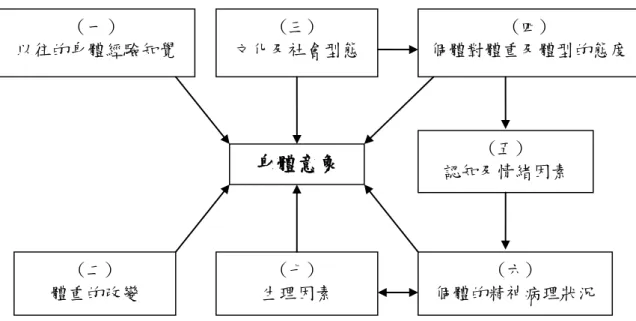別人對自己的看法)等層面,此概念會受到歷史、文化及時尚潮流等因素所影響,並因時間 變化而有所改變。 二、身體意象的特質與特性 身體意象之所以廣為各研究領域探討,乃是因為它是一種多層面心理經驗的呈現,足以 影響我們的生活品質。Cash 與 Pruzinsky (1990) 提出身體意象有下列七大特點:(一)身體 意象是對身體與身體經驗的知覺、想法及感覺;(二)身體意象是多面向的;(三)身體意象 的經驗與對自我的感覺是相互糾結在一起的;(四)身體意象是受到社會影響的;(五)身體 意象並非固定或靜止不變的;(六)身體意象會影響到訊息的處理;(七)身體意象會影響行 為。Fallon (1990) 及劉偉帄(1997)等學者亦提出相同論點。
Slade (1994) 提出了一個身體意象的模式(A Model of Body Image)。如圖 1。
圖 1 身體意象模式(Slade, 1994)
Slade (1994) 指出身體意象至少會受到七個因素的影響:(一)以往的身體經驗知覺
(History of sensory input to body experience),指各體對自己外表、身材、體型的知覺,是屬於
「身體的心理呈現」。(二)體重的改變(History of weight change/fluctuation),通常發生於體重
過胖或過瘦的族群;這些體重異常的族群往往會因為體重的變化而在不同的時期產生不同的
身體意象。(三)文化及社會型態(Cultural and social norms),個體的身體意象會受到社會文化
為瘦才是理想的體型。(四)個體對體重及體型的態度(Individual attitudes to weight and shape),身體意象會因為不同的背景變項而有所不同,如性別、運動員和非運動員。同時, 個體對體重及體型的態度也會受到社會文化型態影響。(五)認知及情緒因素(Cognitive and
affective variables),對自己身體的期望,如卡路里的攝取,會影響個體對體型的評價。(六)
個體精神病理狀況(Individual psychopathology),通常發生在厭食症或貪食症的族群,這些
個體通常會有身體意象扭曲(body image distortion)的徵兆,屬於內在層面的部份。(七)生
理因素(Biological variables),是指個體每天成長中的改變。
参、身體意象與性別之相關探討
一般人都認為女性會比較在意外表的問題,而男性則比較不會有這方面的問題,但是實 際上對男性而言,社會文化的期待和男體之間其實存在著複雜的關係;也因為這樣的迷思, 因此在過去對身體意象的研究中,主要都把焦點放在女性身上,而未能考慮到在父權體制下 對男性身體意象的男子氣概形塑,也未考慮到這樣的身體意象對男性心理和情緒有何影響 (Lee & Owens, 2002)。許多學者皆提出男女兩性在身體意象上的差異,研究指出,女性通常比男性對自己的身 體外表感到不滿,女性通常也較男性對自己的身體外觀裝扮更為注重(Wright, 1989; Cok, 1990;
周玉真,1992;張錦華,1998;盧俊宏、黃瀅靜,1999)。男性較女性有較正向的身體意象,
己的身體意象感到不滿。隨著時代的潮流,男性對身體意象已日漸重視,不滿意自己身體意 象的男性有日漸增的趨勢。
Adame, Johnson 與 Cole (1989) 以 243 位大學生為對象(男 123 人,女 120 人),評估身
文)。取自全國博碩士論文資訊網。(系統編號 085NCUE0464023)。
盧俊宏、黃瀅靜(1999)。大學生社會體型焦慮、身體質量指數和運動行為之關係研究。大 專體育學刊,1(2),129-137。
鍾霓(2004)。大學生身體意象與瘦身消費行為之研究(碩士論文)。取自全國博碩士論文資
訊網。(系統編號 092PCCU0383033)。
Adame, D. D., Johnson, T. C., & Cole, S. P. (1989). Physical fitness, body image, and locus of control in college freshman men and women. Perceptual and Motor Skills, 68, 400-402. Adame, D. D., Frank, R. E., Serdula, M. K., Cole, S. P., & Abbas, M. A. (1991). The relationship of
self-perceived weight to actual weight, body image and health behaviors of college freshmen.
New York, NY: Guilford Press.
Botta, R. A. (2003). For your health? The relationship between magazine reading and adolescents’ body image and eating disturbances. Sex Roles, 48, 389-399.
Cash, T. F., & Pruzinsky, T. (1990). Body image: Development, deviance, and change. New York, NY: Guilford Press.
Cok, F. (1990). Body image satisfaction in Turkish adolescents. Adoescence, 98, 409-413.
Davis, C. (1997). Body image, exercise and eating behaviors. In K. R. Fox (Ed.), The physical self:
From motivation to well-being (pp.143-174). Champaign, IL: Human Kinetics.
Demarest, J., & Langer, E. (1996). Perception of body shape be underweight, average and overweight men and women. Perceptual and Motor Skills, 83, 569-570.
Fallon, A. (1990). Culture in the mirror: Sociocultural determinants of body image. In T. F. Cash & T. Pruzinsky (Eds.), Body image: Development, deviance, and change (pp. 80-109). New York, NY: Guilford Press.
Frederick, C. J. (1993). The gendered experience of aerobic exercise classes: Exploring body image
as a leisure constraint for undergraduate students (Doctoral dissertation) Available from
University Microfilms. (No. MM84495)
30-84.
Keel, P. K., Fulkerson, J. A., &Leon, G. R. (1997). Disordered eating precursors in pre-and early adolescent girls and boys. Journal of Youth and Adolescence, 26, 203-216.
Lee, C. & Owens, R. G. (2002). Men and their bodie: The psychology of men’s health. Buckingham: Open University Press.
Lewis, R. N., & Scannell, E. D. (1995). Relationship of body image and creative dance movement.
Perceptual and Motor Skills, 81, 155-160.
McCabe, M. P., &Ricciardelli, L. A. (2003). Socioculture Influences on body image and body changes among adolescent boys and girls. Journal of Social Psychology, 143(1), 5-26.
Murray, S. (1999). Eating disorders and criticism of coltural ideals. European Eating Disorders
Review, 7, 204-212.
Schilder, P. (1935). The image and appeareance of the human body; studies in the constructive
energies of the psyche. London, England: Kegan Paul.
Slade, P. D. (1994). What is body image? Behavior Research and Therapy, 32(5), 497-502.
Wright, M. R. (1989). Body imagg satisfaction in adolescent girls and boys: A longitudinal study.
